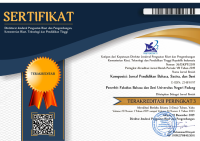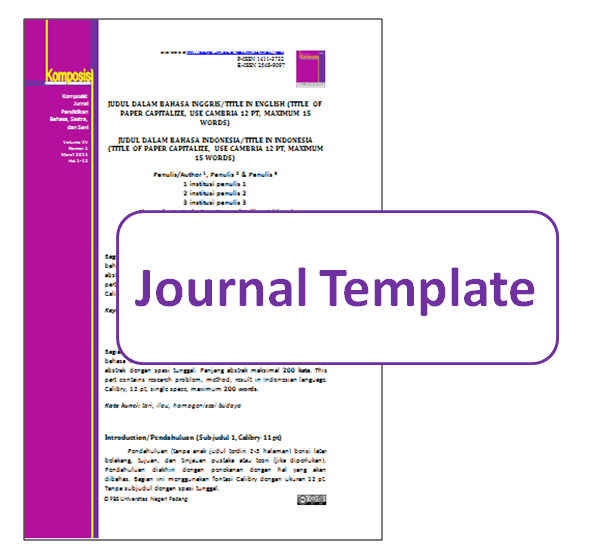The Effectiveness of Scaffolding Model in Teaching Reading at Senior High Schools
Jufri Jufri
Abstract
This research is aimed at identifying the students’ ability in reading by using scaffolding teaching model. This is an experimental research that was carried out at senior high school. There were three senior high schools in Padang that became the location of the research, namely SMAN 1, SMAN 7 and SMAN 8 Padang. The population for this research consisted of the students studying at grade X at the three schools respectively. Meanwhile, the sample was taken by using cluster random sampling technique. The whole number of sample was 192 students, namely, 64 students studying at each school. The research instrument used in this research was reading test consisting of 30 items. After carrying the research for about three months the researcher found the result as follows. The findings of the research indicated that the students’ reading achievement taught by scaffolding model was better than those who were taught by conventional model. To prove it, the researcher used t-test formula. The result showed that scaffolding model gave significant effect towards the students reading ability compared to the conventional one.
Keywords
scaffolding, model, conventional, ability, achievement
References
Alderson, J. Charles. (2005). Assessing Reading. New York: Cambridge University Press.
Arends, Richard I. (2009). Learning to Teach. New York: McGraw Hill.
Axford, Beverley and Pam Harders and Fay Wise (2009). Scaffolding Literacy: An Integrated and Sequential Approach to Teaching Reading, Spelling and Writing. Victoria Australia: Acer Press
Benz, C. & Cynthia M. S. (2006). College Reading 4. Boston: Heinle Cencage Learning.
Blachowicz, Camille and Donna Ogle (2008). Reading Comprehension Strategies for Independent Learners. New York: The Guilford Press
Blanchard, K. & Root, C. (2007). For Your Information. Reading and Vocabulary Skills. Second Edition. New York: Pearson Education Inc.
Byram, M. (2004). Genre and genre-based teaching. The Routledge Encyclopedia of Language Teaching and Learning (pp. 234-237). London: Routledge.
Cohen, R. F. & Judy L M. (2004). North Star. Reading and Writing. New York: Pearson Education Inc.
Fontaine, L. (2004. Text and Texture: Systemic Functional Viewpoints on the Nature and Structure of Text. Paris: Harmattan.
Grabe, W. & Fredricka L. S. (2002). Teaching and Researching Reading. New York: Longman Pearson Education.
Langan, J. (2012). Reading and Study Skills. New York: McGraw-Hill Book Company.
McNamara, D. S. (2007). Reading Comprehension Strategies. Theories, Interventions,and Technologies: New York: Lawrence Elrbaum Associates.
Moreillon, J. (2007). Collaborative Strategies for Teaching Reading Comprehension: Maximazing Your Impact. Chicago: American Library Association.
Paltridge, B. (1996). Genre, Text Type, and the Language Learning Classroom. ELT Journal, 50/3: 237-243.
Richardson, J. S., Morgan, Raymond F., Fleener, Charlene E. (2012). Reading to Learn in the Content Areas. Eight Edition. USA: Wadsworth.
Swales, J. M. (1990). Genre Analysis: English in Academic and Research Settings. Cambridge, UK: Cambridge University Press.
DOI:
https://doi.org/10.24036/komposisi.v22i2.115511
Refbacks
There are currently no refbacks.
Copyright (c) 2021 Komposisi: Jurnal Pendidikan Bahasa, Sastra, dan Seni
This work is licensed under a
Creative Commons Attribution-NonCommercial 4.0 International License .
Komposisi: Jurnal Pendidikan Bahasa, Sastra, dan Seni , a peer-reviewed online journal in languages, literature, and arts education.
Printed ISSN 1411-3732 , Online ISSN 2548-9097 .
Currently, Komposisi: Jurnal Pendidikan Bahasa, Sastra, dan Seni is indexed by: View My Stats
Visitors since February 2017:
Statcounter <div class="statcounter"><a title="web analytics" href="http://statcounter.com/" target="_blank"><img class="statcounter" src="//c.statcounter.com/11239717/0/d5796c6b/0/" alt="web analytics"></a></div> View My Stats
Published by:
Universitas Negeri Padang (UNP) Address: Faculty of Languages and Arts (FBS) Universitas Negeri Padang. Jl Prof. Dr. Hamka Air Tawar Barat, Padang - West Sumatera -Indonesia Telp/Fax. +62751 7053363 Home page: http://ejournal.unp.ac.id/index.php/komposisi | e-mail:komposisi.fbsunp @ fbs.unp.ac.id | cc: havid_a @ fbs.unp.ac.id
https://m.certified-lighting.com/
Server Luar
slot88
King Wood Car Care slot gacor
scam
situs toto
bandar togel
bandar togel
Slot Gacor Hari ini
situs toto
situs toto
toto togel
togel online
topup murah
harapan777
AMDBET
toto togel
slot88
login bayar4d
macau303
slot resmi apk slot online Slot Maxwin
situs toto
sakti55
situs toto felix168
nextogel
NEXTOGEL
NEXTOGEL
NEXTOGEL
NEXTOGEL
NEXTOGEL
NEXTOGEL
NEXTOGEL
NEXTOGEL
NEXTOGEL
NEXTOGEL
NEXTOGEL
NEXTOGEL
NEXTOGEL
NEXTOGEL
NEXTOGEL
NEXTOGEL
NEXTOGEL
NEXTOGEL
NEXTOGEL
NEXTOGEL
NEXTOGEL
NEXTOGEL
NEXTOGEL
NEXTOGEL
NEXTOGEL
NEXTOGEL
NEXTOGEL
NEXTOGEL
NEXTOGEL
NEXTOGEL
NEXTOGEL
JEPETOGEL
JEPETOGEL
JEPETOGEL
JEPETOGEL
KIM369
KIM369
KIM369
KIM369
KIM369
KIM369
KIM369
KIM369
KIM369
KIM369
situs toto toto slot kuntogel
situs toto toto slot sendok88
togel online toto slot https://www.eaglehighplantations.id/
toto macau
slot gacor slot gacor
batak5d toto slot Slot88 www.onscripture.com
slot online
situs toto
situs gacor bandar togel resmi toto togel https://montreallawfirm.com
wild west gold sering pecah
Toto 4D
slot88
toto macau
Situs Toto
Situs Toto
https://mercubuana.org/
Toto 4d
toto 4d
Toto 4D
toto 4d
info rtp akurat malam ini
Wanita Subang Beli mobil dari Nolimit city
rahasia Cuan Aztech Gems
Gatot kaca Buat TKW Jadi jutawan
Rahasia sukses bermain Mahjing wins
harapan princess starlight
Harapan sweet bonanza
taktik gates of olympus xmas
dukungan gates olympus
rahasia sukses bermain mahjong ways
Situs togel
slot gacor 2025
luxury89
Sulebet
sulebet
oja89
basic4d
situs toto togel online
vipbet888
momo128 login
https://garudafood.org/
jpmania mesin128
mesin128
mesin128
oja89
slot gacor
jumat4d slot login
https://pintu-pro.id/
slot gacor
Buat yang suka cari link slot gacor hoki69 maxwin tiap hari, ini tempat yang paling sering gue datengin.
choicehomecontractors.com
sarangslot
slot 4d gacor hari ini
Toto 4D
https://up2m.pkr.ac.id/jepangbet/
slot
simpatitogel
slot gacor hari ini
slot gacor
slot
https://unesa.id/
xl bola
slot gacor
vega168
Togel 4D
slot gacor
bandar togel
slot777
sbobet
https://sidangmakmur.desa.id/sida/
pin4d
situs toto situs toto SON4D : KONSEP SLOT TYPE MODIFIKASI MOTOR GAYA THAILAND TERBARU ARI69 situs slot gacor 











